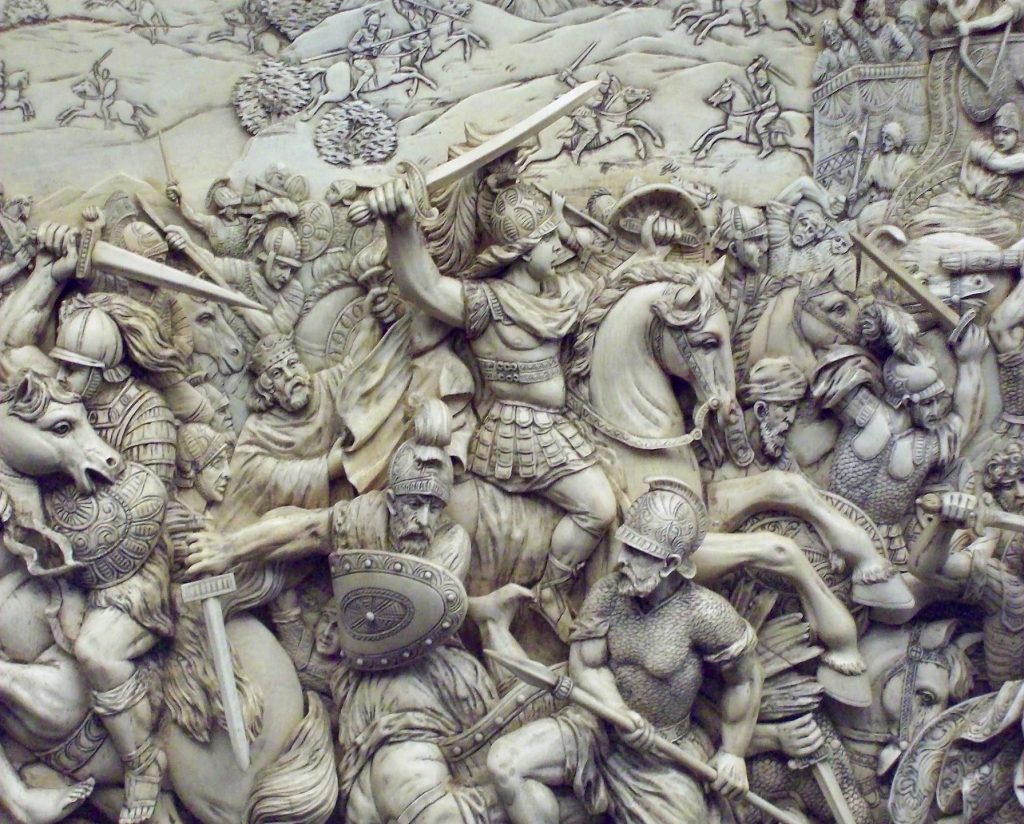On the morning of October 1, 331 BCE, Alexander could see for the first time the vast Persian army in front of him. He knew that this was going to be the decisive battle, that if he beat Darius, the entire Persian Empire would be his.1
During the spring of 331 BCE and after beating Darius at Issus, Alexander returned to Tyre. Darius avoided previous attacks from Alexander since his army had been destroyed during the Battle of Issus. To solve that, Darius tried to negotiate with Alexander three times, but Alexander rejected all of them. To stop Alexander’s advance, Darius sent his general Mazaeus and 3,000 men to stop him. This defensive movement did not work, and Mazaeus went back to Darius with disappointing news. Darius had to find yet another solution for stopping Alexander’s army, which was steadily advancing towards the heart of the Persian empire.2
After crossing the Euphrates, Alexander avoided taking a southern route and went through Babylon. In the other side of the Tigris, Darius was waiting for him, but when Alexander arrived, Darius’ army had disappeared. According to experts’ calculations, around October, when Alexander was crossing the Tigris, he observed a force of 1,000 men trying to spy on Alexander’s army. Alexander chased them, but he did not manage to kill or capture them all, but caught only some of them. But it was more than enough to know where the Persian army was camped, right on the wide esplanade of Gaugamela.3

Alexander realized that a victory at Gaugamela would bring about the end of the Achaemenid Empire, and that Babylon, Persepolis, and Susa would be his, but this was not going to be easy. Darius, who learned from the mistakes he had made previously at the Battle of Issus, chose Gaugamela, a vast open and flat field, where he could deploy his vast army. Alexander stopped where he was for four days to rest his army and create an entrenched camp where he could deploy his forces. Then, he began to plot a strategy for the crude battle ahead. First, before heading into the battle, he and some of his best generals went on a nocturnal march to know the enemy’s exact position. When he saw Darius’ vast army, Alexander halted and pondered whether to attack or not. Finally, he decided that the best choice would be to wait, and that was what he did, but not before checking the countryside.4
When Darius noticed the advancement of the enemy, he began to set up a strategy for the battle with his huge army. The ancient historian Arrian describes Darius’ army: “40,000 cavalry, 1,000,000 infantry, 200 scythed chariots and fifteen elephants,” and Plutarch estimated that Darius had 1,000,000 troops.5 Although some modern historians disagree with the numbers, it was considerably larger than Alexander’s army. Darius’ strategy was to envelop both flanks of his enemy, trusting the greater length of his battle front and basing his hopes on two powerful cavalry wings.6 One of the most important satraps, Bessus, commanded the left flank, while the other flank was commanded by Mazaeus. Darius had provided his forces with better and more effective arms, with longer swords and a short thrusting-spear for his horsemen.5
On the other hand, Alexander’s forces consisted of 7,000 cavalry and 40,000 infantry, according to the ancient historian Arrian. Alexander’s army was divided into two: Alexander commanded the right flank while Parmenion commanded the left one. Alexander used his Companion cavalry to fight. He was accompanied by the Paioan and Greek cavalry. Meanwhile, the mercenary cavalry was positioned with the veterans on the right flank. On the left was Parmenion. They were to maintain their position while Alexander delivered the crucial strike from the right. Cretan mercenaries were stationed at the right-center position. Behind them came Thessalian cavalry and Achaean mercenaries under Phillip’s command. Another section of the allied Greek cavalry was to their right. The Greeks were outmanned by over five to one in cavalry. Mercenaries made up the majority of the second line. How could he defeat Darius and win this battle with such an outnumbered army? Alexander was quoted as having said, “there is nothing impossible for him who will try.”4
On the morning of October 1, 331 BCE, Alexander could see for the first time the vast Persian army in front of him. Alexander switched his original strategy and his army started attacking in a phalanx formation, creating an angle of 45 degrees. Darius saw the opportunity to attack Parmenion’s left flank and dispatched some of his cavalry and infantry, while Alexander’s army was focused on fighting the Persian soldiers with his phalanxes. Alexander marched through the Persian army supported by his Companion Cavalry, in order to attack the right wing, while the infantry engaged the Persian warriors in the center. His plan was to draw as many Persian cavalry to the sides as possible, creating a gap in the enemy line from which he could deliver in the middle a fatal blow to Darius. This needed to be done at the exact moment, and Alexander knew he had to take the initiative. When Darius was forced to launch an attack, he did it.1

The Scythian horsemen on the left flank began the battle by flanking the right wing of Alexander’s army. A bloody clash ensued between the two sides. Despite the large difference in the number of men Darius had, the Macedonian right wing managed to resist. The resistance of the Macedonian army on this flank managed to tilt the victory to Alexander’s side. After having opened a breach in the Persian army, Alexander turned his attack towards the center, but his onslaught was partially stopped by the ambush of Aretes, who thought to stop Alexander’s final attack, thinking that the war on the flanks was still open when the Macedonians had already crushed the Persians. The Persians who rode on the flanks were surprised by Alexander’s army, which did not hesitate to massacre them.10
Darius fired his chariots towards Alexander’s command, which were stopped by the Agrians and javelin throwers. The chariots that went through the rain of arrows from the javelin throwers surprised the Macedonians, who had to open their ranks to be able to counter the attack and let the chariots pass without danger to the Macedonians.11
Alexander’s strategy was beginning to pay off. The Persians, without realizing it, were getting closer to the Greek flanks, which was exposing the interior of the Persian army. Taking advantage of the moment in which the Persian cavalry was fighting on the flanks, Alexander, along with the men he had managed to gather for the final attack, went to the interior of the Persian army, managing to attack the royal guard of Darius and the Greek mercenaries, who were overwhelmed by Alexander and his forces. Darius, seeing himself in grave danger, fled with the army that was still standing.

After the flight of Darius, Alexander might have gone after him had it not been for the news coming from the left flank, where Parmenion was struggling to hold back the Persians, who had surrounded the Macedonians. Alexander was faced with a key decision for the development of his future conquest of the Persian Empire: should he go after Darius, kill him and end the war, but in exchange he would lose a large part of his army; or should he help Parmenion and save the army and then go after Darius? Alexander opted to help Parmenion, giving Darius time to escape.12
When Alexander reached the left flank, a fierce and bloody battle ensued between the Macedonian left wing and the Persian right flank, where the fiercest divisions of his army were located. Alexander and his cavalry disposed without too much difficulty of the Persian right wing, putting an end to the fierce but glorious battle of Gaugamela.13
It had been a terrible defeat for the Persians and an unexpected victory for Alexander. After the Battle, Alexander made numerous prisoners, according to Arrian, more than 300,000 Persian were killed and 300,000 were captured, while Alexander’s army was almost intact, less than 1,000 men were killed, which makes this battle even more epic.14
- J.F.C. Fuller, The Generalship of Alexander the Great (New York: Da Capo Press, 2003), 170. ↵
- Nicomedia Arrian, The Anabasis of Alexander (The Free Online Library,1893), 153. ↵
- Nicomedia Arrian, The Anabasis of Alexander (The Free Online Library,1893), 154. ↵
- J.F.C. Fuller, The Generalship of Alexander the Great (New York: Da Capo Press, 2003), 166. ↵
- J.F.C. Fuller, The Generalship of Alexander the Great (New York: Da Capo Press, 2003), 164. ↵
- Victor Davies Hanson, Carnage and Culture: Landmark Battles in the Rise to Western Power (Anchor Books, 2007), 61. ↵
- J.F.C. Fuller, The Generalship of Alexander the Great (New York: Da Capo Press, 2003), 164. ↵
- J.F.C. Fuller, The Generalship of Alexander the Great (New York: Da Capo Press, 2003), 166. ↵
- J.F.C. Fuller, The Generalship of Alexander the Great (New York: Da Capo Press, 2003), 170. ↵
- Nicomedia Arrian, The Anabasis of Alexander (The Free Online Library,1893), 166. ↵
- Nicomedia Arrian, The Anabasis of Alexander (The Free Online Library,1893), 167. ↵
- Nicomedia Arrian, The Anabasis of Alexander (The Free Online Library,1893), 168. ↵
- Nicomedia Arrian, The Anabasis of Alexander (The Free Online Library,1893), 170. ↵
- J.F.C. Fuller, The Generalship of Alexander the Great (New York: Da Capo Press, 2003), 180. ↵



4 comments
Kelly Arevalo
Hello Daniel. Great article! It was really interesting to learn a bit more about Alexander The Great’ combats and strategies. I like to see you added pictures to illustrate Alexander’s progress, although they were slightly confusing at first. I would like to read another article about different battles that took place during the expansion of the roman empire or any other important battle. Good job!
Seth Roen
What a great article, and truly Alexander the Great was a crazy gambler, but he did manage to conquer most of the known world. But the Battle of Gaugamela was indeed his biggest gamble during his life. I like how you used imagery from the title image to the formations used during the battle. It helps shows some of the finer detail in the battle that could get lost in the text.
Gisselle Baltazar-Salinas
I really enjoyed your article! It kept me engaged the whole time, I especially enjoyed the pictures used to show Alexanders strategy as the battle ensued. I believe his best trait as a general was his ability to change his strategy in battle as needed under pressure. The part about Alexander having to decide in the heat of battle on if he should pursue Darius, or help Parmenion on the left flank really showed who he was as a leader. Instead of hunting down Darius and risking losing a large portion of his army he went to help the left flank. Nonetheless, it was a great article!
Carlos Hinojosa
I am convinced that Alexander the Great was one of those talented people that can be put in any of Era of time, and they would have succeeded. I know if Alexander was put into modern day with some training on how certain things worked could easily conquer a good chunk of the world. If Alexander never died to disease who know how strong the Macedonia Empire would have been. Maybe, even have a better succession line then what they had originally. Very good article, very well-made.